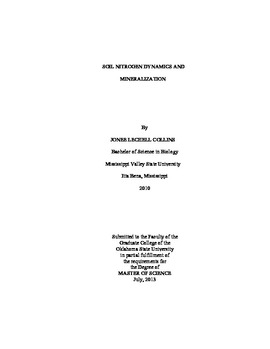| dc.contributor.advisor | Deng, Shiping | |
| dc.contributor.author | Collins, Jo'Nee Lechell | |
| dc.date.accessioned | 2014-09-24T14:18:27Z | |
| dc.date.available | 2014-09-24T14:18:27Z | |
| dc.date.issued | 2013-07-01 | |
| dc.identifier.uri | https://hdl.handle.net/11244/11149 | |
| dc.description.abstract | A group of scientists in the United Kingdom recently proposed that mineralization of native soil organic matter is not regulated by the size, activity or composition of the soil microbial biomass. This was termed the Regulatory Gate hypothesis, which challenges one of the long held theories in soil microbiology that mineralization processes in soil are predominantly driven by microbial activities. In this study, the main objective was to test the Regulatory Gate hypothesis through evaluation of soil nitrogen (N) dynamics and mineralization by monitoring KCl-extractable N content in three soils following a series of treatments with or without laboratory incubations. The soils were originated from a century-old continuous winter wheat experiment. For over a century, one of the soils had added cattle manure once every four years (Manure) and another had been fertilized with inorganic phosphorus every year (P). An untreated control (Check) was included for comparison. These soils had significantly different fertility levels, evidenced by nutrient levels as well as grain production of wheat. Content of KCl-extractable N were low in the air-dried soil, but increased about 4-fold following rewet and incubation at room temperature for 10 days. Additional 10 days incubation did not lead to significant changes in the KCl-extractable N in the Check soil, but led to significant reduction in the Manure soil. Autoclaving led to release of KCl-extractable N in all soils tested, with Manure soil significantly higher than P or Check soil. Rewet followed by 10-day incubation resulted in the release of inorganic N that was significantly higher than the air-dried soils. Data obtained this study seems to be supporting the Regulatory Gate hypothesis, but simultaneous N mineralization and immobilization processes complicate the interpretation of data. Although changes of total N due to these treatments were undetectable, the significant changes of KCI-extractable N demonstrated the complexity of N dynamic of soil and warrant further studies to reveal the underline basis for the observed changes and relative contributions for mineralization and microbial immobilization of N in soil. | |
| dc.format | application/pdf | |
| dc.language | en_US | |
| dc.publisher | Oklahoma State University | |
| dc.rights | Copyright is held by the author who has granted the Oklahoma State University Library the non-exclusive right to share this material in its institutional repository. Contact Digital Library Services at lib-dls@okstate.edu or 405-744-9161 for the permission policy on the use, reproduction or distribution of this material. | |
| dc.title | Soil Nitrogen Dynamics and Mineralization | |
| dc.type | text | |
| dc.contributor.committeeMember | Anderson, Michael P. | |
| dc.contributor.committeeMember | Stoecker, Art | |
| osu.filename | Collins_okstate_0664M_12936.pdf | |
| osu.accesstype | Open Access | |
| dc.description.department | Environmental Sciences | |
| dc.type.genre | Thesis | |
